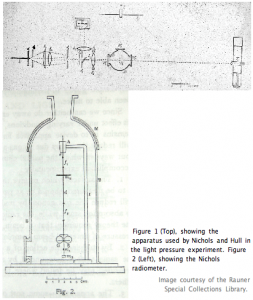Nichols radiometer on:
[Wikipedia]
[Google]
[Amazon]
 A Nichols radiometer was the apparatus used by
A Nichols radiometer was the apparatus used by
The Pressure due to Radiation
''The Astrophysical Journal'',Vol.17 No.5, p. 315-351 (1903)
1903 Nichols and Hull's experiments
1933 Bell and Green's experiment
{{DEFAULTSORT:Nichols Radiometer Electromagnetic radiation meters
 A Nichols radiometer was the apparatus used by
A Nichols radiometer was the apparatus used by Ernest Fox Nichols
Ernest Fox Nichols (June 1, 1869 – April 29, 1924) was an American educator and physicist. He served as the 10th President of Dartmouth College.
Early life
Nichols was born in Leavenworth County, Kansas, and received his undergraduate deg ...
and Gordon Ferrie Hull Gordon Ferrie Hull (October 7, 1870 in Garnet, Ontario, Canada – October 7, 1956) was a Canadian-American mathematician, teacher and physicist, especially known for the experimental detection of the radiation pressure exerted by light which he ac ...
in 1901 for the measurement of radiation pressure
Radiation pressure is the mechanical pressure exerted upon any surface due to the exchange of momentum between the object and the electromagnetic field. This includes the momentum of light or electromagnetic radiation of any wavelength that is a ...
. It consisted of a pair of small silvered glass mirror
A mirror or looking glass is an object that reflects an image. Light that bounces off a mirror will show an image of whatever is in front of it, when focused through the lens of the eye or a camera. Mirrors reverse the direction of the im ...
s suspended in the manner of a torsion balance
A torsion spring is a spring that works by twisting its end along its axis; that is, a flexible elastic object that stores mechanical energy when it is twisted. When it is twisted, it exerts a torque in the opposite direction, proportional ...
by a fine quartz
Quartz is a hard, crystalline mineral composed of silica ( silicon dioxide). The atoms are linked in a continuous framework of SiO4 silicon-oxygen tetrahedra, with each oxygen being shared between two tetrahedra, giving an overall chemical ...
fibre within an enclosure in which the air pressure could be regulated. The torsion head to which the fiber was attached could be turned from the outside using a magnet
A magnet is a material or object that produces a magnetic field. This magnetic field is invisible but is responsible for the most notable property of a magnet: a force that pulls on other ferromagnetic materials, such as iron, steel, nicke ...
. A beam of light
Light or visible light is electromagnetic radiation that can be perceived by the human eye. Visible light is usually defined as having wavelengths in the range of 400–700 nanometres (nm), corresponding to frequencies of 750–420 te ...
was directed first on one mirror and then on the other, and the opposite deflections observed with mirror and scale. By turning the mirror system around to receive the light on the unsilvered side, the influence of the air in the enclosure could be ascertained. This influence was found to be of almost negligible value at an air pressure of about 16 mmHg (2.1 kPa
KPA may refer to:
* Keele Postgraduate Association, Keele University, UK, formerly Keele Research Association (KRA)
* Kensington (Olympia) station, London, England, National Rail station code
* Kenya Ports Authority
* ''Kiln phosphoric acid'', a ...
). The radiant energy
Radiant may refer to:
Computers, software, and video games
* Radiant (software), a content management system
* GtkRadiant, a level editor created by id Software for their games
* Radiant AI, a technology developed by Bethesda Softworks for '' ...
of the incident beam was deduced from its heating effect upon a small blackened silver disk, which was found to be more reliable than the bolometer
A bolometer is a device for measuring radiant heat by means of a material having a temperature-dependent electrical resistance. It was invented in 1878 by the American astronomer Samuel Pierpont Langley.
Principle of operation
A bolometer ...
when it was first used. With this apparatus, the experimenters were able to obtain an agreement between observed and computed radiation pressures within about 0.6%. The original apparatus is at the Smithsonian Institution
The Smithsonian Institution ( ), or simply the Smithsonian, is a group of museums and education and research centers, the largest such complex in the world, created by the U.S. government "for the increase and diffusion of knowledge". Founded ...
.
This apparatus is sometimes confused with the Crookes radiometer
The Crookes radiometer (also known as a light mill) consists of an airtight glass bulb containing a partial vacuum, with a set of vanes which are mounted on a spindle inside. The vanes rotate when exposed to light, with faster rotation for more i ...
of 1873.
See also
* Solar sailReferences
* * * E.F. Nichols and G.F. HullThe Pressure due to Radiation
''The Astrophysical Journal'',Vol.17 No.5, p. 315-351 (1903)
External links
1903 Nichols and Hull's experiments
1933 Bell and Green's experiment
{{DEFAULTSORT:Nichols Radiometer Electromagnetic radiation meters